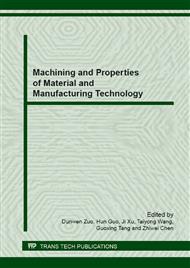[1]
Z.J. Liu, A Comprehensive Evaluation of Risk Control Effect in High and New Technological Innovation Based on F-integral, Ludong University Journal, 25(3)(2009)214-217.
Google Scholar
[2]
Y. Liu, Risk Early Warning Index System for Technological Innovation in Hi-Tech Enterpris, Journal of Shenzhen University, 28(6)(2011), 77-83.
Google Scholar
[3]
Y. Chao. Construction of Risk Early-warning System for Enterprises Technology Innovation, Science & Technology Progress and Policy, 27(17)(2010), 113-115.
Google Scholar
[4]
F.F. Sa, A fast feed forward training algorithm using a modified form of the standard back propagation algorithm, IEEE Trans on Neural Networks, 3(12)(2001)424-430.
DOI: 10.1109/72.914537
Google Scholar
[5]
Q. Liu, S.X. Sun, BP network optimization based on mutative scale chaos optimization algorithm, Application Research of Computers, (4)(2011)1257-1259.
Google Scholar
[6]
J.Y. Jian, Method on Data Element Standardization (5)—Standardization Stages of Data Element, Information Technology & Standardization. (6)(2008)53-55.
Google Scholar
[7]
S. Dehuri, A comprehensive survey on functional link neural networks and an adaptive PSO–BP learning for CFLNN, Neural Computing and Applications. 19(2)(2010)187-205.
DOI: 10.1007/s00521-009-0288-5
Google Scholar
[8]
X.Q. Guo, Application of Chaos in BP Algorithm, Computer Simulation. (6)(2011)215-218.
Google Scholar
[9]
W.G. Jun, BP Algorithm with Chaotic Learning Rate, Computer Engineering. (23)(2010) 168-170.
Google Scholar
[10]
C.N. Scanaill, Technology Innovation Enabling Falls Risk Assessment in a Community Setting, Ageing International. 36(2)(2011)217-231.
DOI: 10.1007/s12126-010-9087-7
Google Scholar
[11]
M. Fiedler, Commercialisation of technology innovations: an empirical study on the influence of clusters and innovation networks,. International Journal of Technology Management. 55(1)(2011)410-437.
DOI: 10.1504/ijtm.2011.041582
Google Scholar
[12]
C.N. Scanaill, Technology Innovation Enabling Falls Risk Assessment in a Community Setting, Ageing International. 36(2)(2011)217-231.
DOI: 10.1007/s12126-010-9087-7
Google Scholar
[13]
A. Schrager, Innovations and Limitations, National Review. 61(18)(2011)34-36.
Google Scholar
[14]
S.X. Dong, J.Z. Xiao, A Metod for Risk Early-warming of Enterprise Organizational Innovation Based on Rough Set and Neural Network, Industrial Engineering and Management. (4)(2006) 97-105.
Google Scholar
[15]
Y.L. X Hong, Research on the Nonlinear Simulation Early-Warning System of the Local Government Debt Risk—Based on Rough Sets and BP Neural Network Integration, Journal of Shanxi Finance and Economics University. 34(3)(2012)1-10.
Google Scholar
[16]
Z. P. Rough set theory and its applications to data analysis, Cybernetics and Systems. 29(1)(1998)661-688.
DOI: 10.1080/019697298125470
Google Scholar
[17]
Z. Xiao, BP neural network with rough set for short term load forecasting, Expert Systems with Applications. 36(1)(2009)273-279.
DOI: 10.1016/j.eswa.2007.09.031
Google Scholar
[18]
T.W. Song, Linear Approximating Method in the Transacting Process of Nonlinear Standardization of Data, Journal of Information Engineering University. (2)(2007)250-253.
Google Scholar
[19]
B.X. Zhi, Research on RMB Exchange Rate Forecasting Model Based on Combining ARIMA with Neural Networks, The Journal of Quantitative & Technical Economics. (6)(2011)64-76.
Google Scholar
[20]
Z.J. Dai, X.W. Chun, Study on the Customer Value Recognition Based on BP Neural Network. (7)(2009)151-156.
Google Scholar


